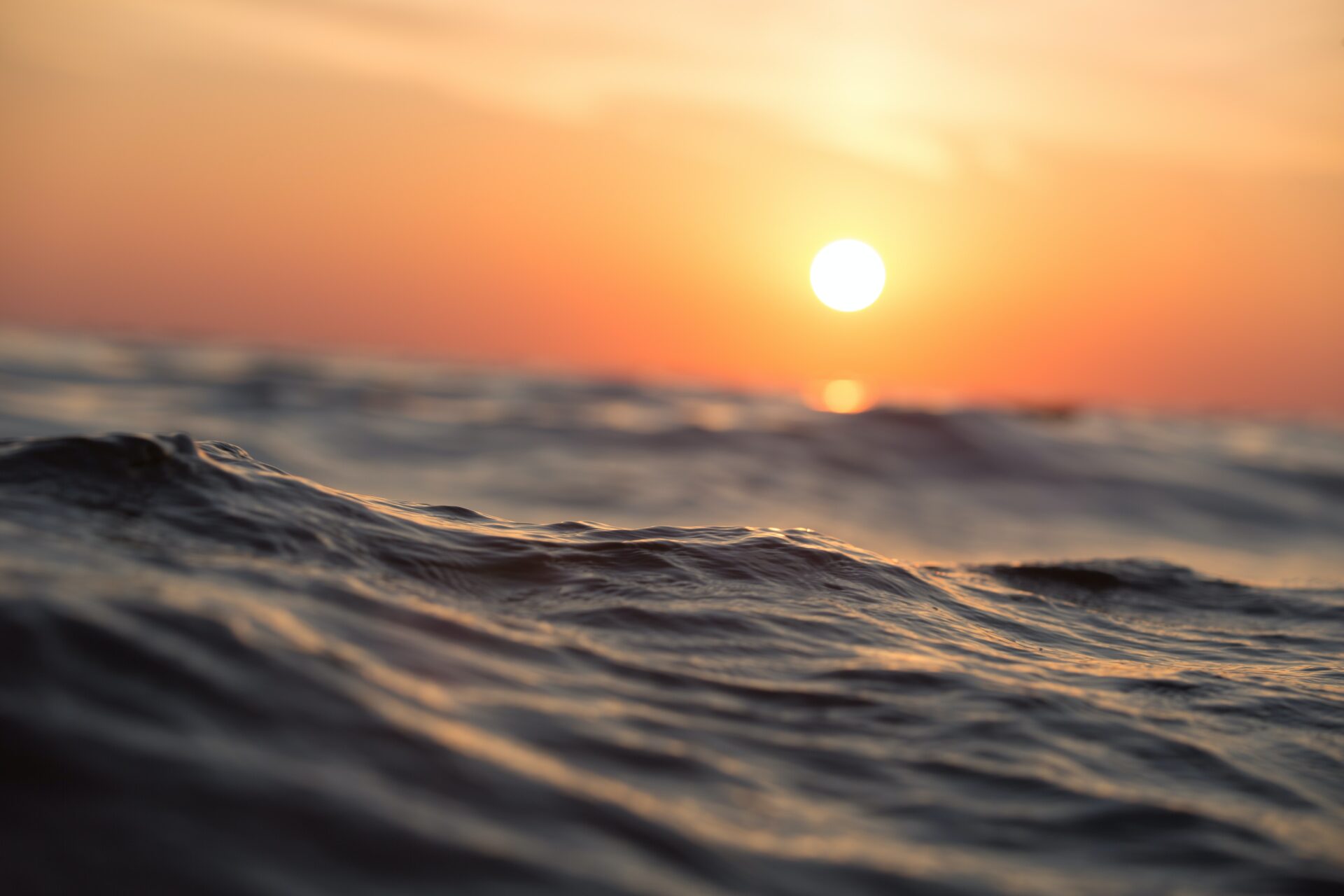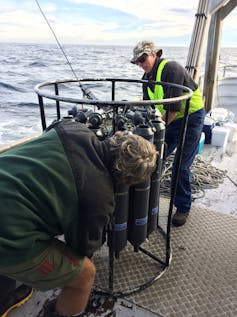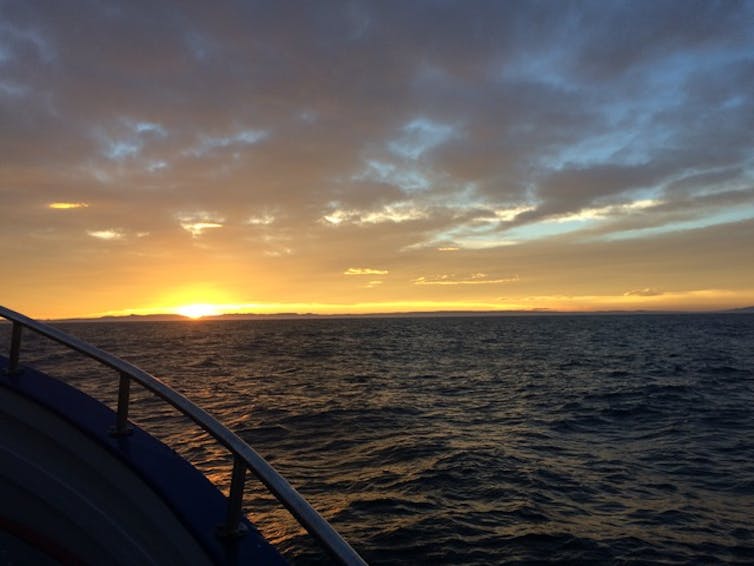
Bacteria uses life’s original energy source to thrive in the ocean’s lightless depths
Chris Greening, Monash University; Rachael Lappan, Monash University, and Zahra F. Islam, The University of Melbourne
There are more than a billion bacteria in just one litre of seawater. How do all of these organisms find the energy and nutrients they need to survive?
In the nutrient-rich waters near the surface of the ocean, the primary energy source is sunlight, which drives photosynthesis, the transformation of light energy into chemical energy. In much of the open ocean, however, a lack of nutrients limits photosynthesis, and in the deep ocean it ceases altogether as there is no sunlight.
Despite this, microbes have found a way to live throughout the vast and dark ocean. How do they do it?
As we report in Nature Microbiology, many ocean bacteria in fact gain energy from two dissolved gases, hydrogen and carbon monoxide, in a process called chemosynthesis. This hidden but ancient process helps maintain the diversity and productivity of our oceans.
When the lights go out, chemosynthesis prevails
We aimed to identify the preferred energy sources of microbes in the world’s oceans.
Humans and other animals depend on eating organic foods, while plants rely on photosynthesis. In contrast, microbes use a myriad of energy sources: solar, organic, and inorganic.
Many eat high-energy gases such as hydrogen and even carbon monoxide, which is poisonous to us. They do so by using special enzymes called hydrogenases and carbon monoxide dehydrogenases.
The world’s oceans contain quite a lot of dissolved hydrogen and carbon monoxide due to various biological and geological processes. Given this, we predicted these gases would be key energy sources for oceanic microbes.
During our five-year study, we surveyed the capabilities and activities of the microbes present in the world’s oceans. We sampled seawater from diverse sites, spanning tropical islands to subantarctic waters. Public data from the global Tara Oceans study were also analysed.
Using a technique called metagenomic sequencing, we discovered the genetic blueprints of all the microbes in our ocean samples. We also took chemical measurements during the expeditions, analysed bacterial cultures, and used mathematical modelling to understand how the bacteria were getting their energy.
In all the samples we analysed, microbes were using enzymes to gain energy from hydrogen and carbon monoxide. As we expected, photosynthesis was the main source of energy in coastal surface waters – but gas-eating microbes grew more common further away from shore and in the deeper ocean.
In nutrient-poor waters, chemosynthesis may be the main strategy for obtaining energy.

Guy Shelley/Monash University, Author provided
Eight distantly related groups, or phyla, of bacteria made the enzymes to use hydrogen and carbon monoxide. Clearly chemosynthesis is a far more widespread strategy in the oceans than previously thought!
Hydrogen and carbon monoxide aren’t the only chemical energy sources supporting ocean bacteria. Building on previous work by others, we found ammonia, sulfide and thiosulfate were also widely used.
Together, all these inorganic energy sources allow diverse microbes to prosper even in the darkest and most nutrient-poor regions of the ocean. As we have previously reported, chemosynthesis even allows a “microbial jungle” to form beneath the ice sheets of Antarctica.
An ancient trait that remains surprisingly widespread today
Chemosynthesis is less well known than photosynthesis, but it has much more ancient roots. Leading theories on the origin of life suggest hydrogen – produced in hydrothermal vents devoid of sunlight – was the first energy source for life. Photosynthesis likely evolved much later, providing the oxygen in the atmosphere that supports human life.
Some ecosystems still exist today that are primarily driven by chemosynthesis, most notably “black smokers”. Here, inorganic energy sources released from underwater volcanoes support complex microbially driven ecosystems, which include giant tube worms (you might have seen these on David Attenborough’s Blue Planet). But it’s conventionally thought that most ecosystems today are either directly or indirectly driven by photosynthesis.
Our findings suggest the situation is more complicated. By presenting the first report of hydrogen consumption in open oceans, we reveal unexpected similarities of marine microorganisms today to their ancient ancestors.
Chemosynthesis remains highly active today and provides a lifeline for oceanic microbes when photosynthesis is low.
The hydrogenases that modern marine bacteria use to consume hydrogen appear to be directly descended from the ancient catalysts that supported the first life. But through billions of years of evolution, they’ve adapted to the lower hydrogen and higher oxygen levels of today.

Guy Shelley/Monash University, Author provided
Interestingly, hydrogen and carbon monoxide appear to have distinct roles for ocean bacteria.
Hydrogen-consuming microbes grow using the slow, steady feed of energy provided by this gas. These bacteria are often ultrasmall and adapted to life with minimal energy, as reflected by our experiments with the polar bacterium Sphingopyxis alaskensis.
In contrast, carbon monoxide is primarily a “last resort” energy source for bacteria lacking light or organic carbon. It provides enough energy to survive until a better meal, but doesn’t allow for much growth. This agrees with previous work showing carbon monoxide dehydrogenase supports survival, but not growth, of various bacteria.
Bacterial survival in a changing world
Through our studies of the oceans and many other environments, it’s now clear that chemosynthesis is a universal process and microbes are actually quite flexible in their diets. Such insights improve our understanding of how ocean microbes survive, produce and consume nutrients, and adapt to their environment.
In turn, we are better able to predict how they may respond to a changing climate and other pressures. The deep ocean, often considered Earth’s “final frontier”, no doubt holds many other secrets big and small.![]()
Chris Greening, Professor, Microbiology, Monash University; Rachael Lappan, Group Leader and ARC DECRA Fellow, Monash University, and Zahra F. Islam, Postdoctoral research fellow, The University of Melbourne
This article is republished from The Conversation under a Creative Commons license. Read the original article.


